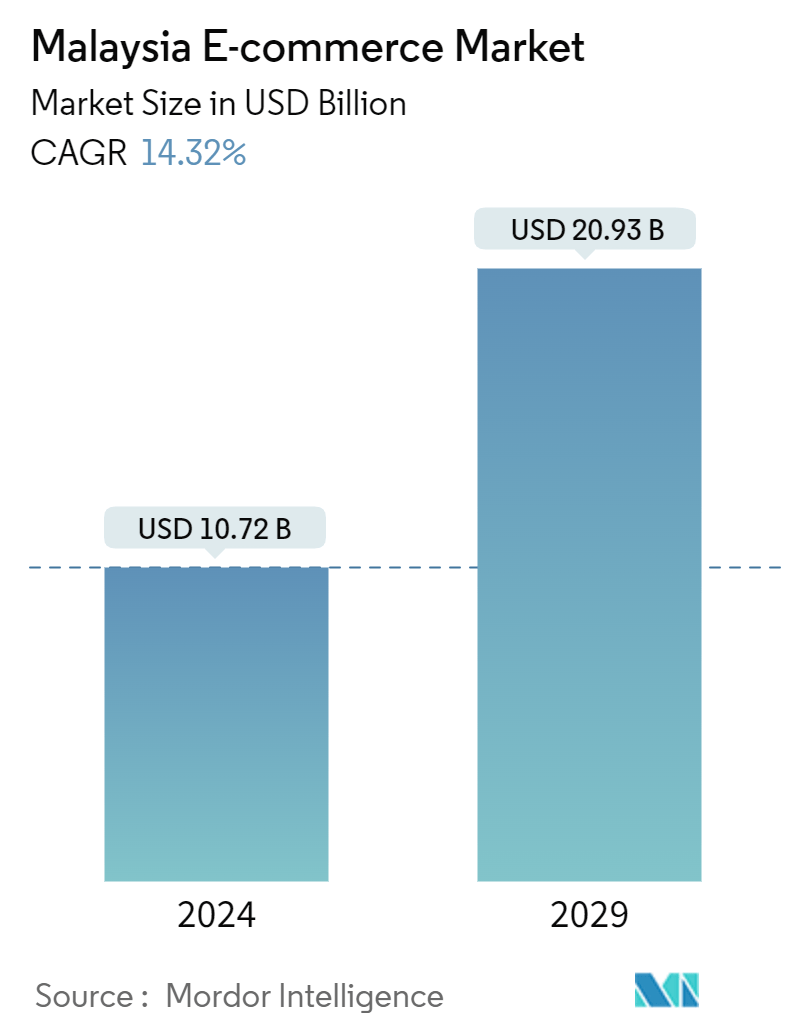Market Size of Malaysia E-commerce Industry

| Study Period | 2019 - 2029 |
| Base Year For Estimation | 2023 |
| Market Size (2024) | USD 10.72 Billion |
| Market Size (2029) | USD 20.93 Billion |
| CAGR (2024 - 2029) | 14.32 % |
| Market Concentration | Medium |
Major Players
*Disclaimer: Major Players sorted in no particular order |
Malaysia E-commerce Market Analysis
The Malaysia E-commerce Market size is estimated at USD 10.72 billion in 2024, and is expected to reach USD 20.93 billion by 2029, growing at a CAGR of 14.32% during the forecast period (2024-2029).
- The e-commerce market is experiencing growth due to increasing internet penetration, access in developing economies, smartphone usage, technological advancements, and rapid urbanization.
- The primary factors fueling the market's expansion are consumer electronics, fashion and apparel, and personal care industries. Significant investments in consumer electronics, personal care, and fashion and clothing sectors are opening up possibilities for growth.
- According to Statistics Malaysia, in 2023, almost all individuals in the country accessed the internet through their mobile phones. Additionally, about 38% of users reported using the internet from their laptops, while 13% reported utilizing alternative mobile gadgets.
- The Malaysian government’s proactive stance in fostering a digital economy has played a crucial role. Initiatives like the Digital Free Trade Zone (DFTZ) and the National E-commerce Strategic Roadmap have been instrumental in encouraging both local and international players to participate in the Malaysian e-commerce market. These policies not only streamlined regulatory processes but also provided incentives for e-commerce businesses, thereby catalyzing growth and innovation in the market.
- The government is implementing supportive measures for e-commerce. For example, in October 2023, PIKOM and e-Commerce Malaysia endorsed a careful and positive strategy for TikTok Shop, emphasizing the importance of proactive discussions with industry associations and e-commerce enablers. The focus was on local policies and developing the skills of local creators and e-commerce facilitators rather than foreign ones by providing workshops, training, and platform tools that help local players succeed in the digital market ethically.
- E-commerce companies recognize the importance and requirement of mobile commerce (m-commerce) in developing their existing and upcoming omnichannel strategies through effective, easy-to-use applications. During the forecast period, the rollout of 5G is expected to be a key driver of increased mobile traffic from consumer-facing websites across the country.
- According to Malaysia's Commercial Crime Investigation Department (CCID), by September 2023, Malaysia had recorded over 8,800 e-commerce scams. The tenacity of fraud hindered the market's expansion, which eroded purchasers' faith.
Malaysia E-commerce Industry Segmentation
E-commerce includes business-to-business (B2B) and business-to-consumer (B2C) transactions and internal organizational transactions that support these activities. The study tracks essential market factors, underlying growth influencers, and significant market vendors to provide estimations and growth rates for the forecast period. The study also examines the overall impact of COVID-19 on the market.
The Malaysian e-commerce market is segmented by B2C e-commerce (beauty and personal care, consumer electronics, fashion and apparel, food and beverage, furniture and home, and others (toys, DIY, media, etc.)) and B2B e-commerce. The market sizes and forecasts are provided in terms of value (USD) for all the above segments.
| By B2C ecommerce | ||||||||
|
| By B2B ecommerce | |
| Market size for the period of 2017-2027 |
Malaysia E-commerce Market Size Summary
The Malaysian e-commerce market is experiencing significant growth, driven by high internet and mobile penetration rates, as well as supportive government initiatives. The government's proactive measures, such as the Digital Free Trade Zone and the Digital Economy Blueprint, have created a favorable environment for e-commerce businesses. These initiatives provide tax incentives, infrastructure development, and regulatory support, attracting both local and international players. The National E-Commerce Council and the National E-Commerce Strategic Roadmap 2.0 further bolster the sector by focusing on increasing e-commerce adoption, enhancing ecosystem growth, and strengthening e-commerce laws and regulations. Despite challenges like e-commerce fraud, the market continues to expand, fueled by the shift in consumer behavior towards online shopping, especially during the COVID-19 pandemic.
The e-commerce sector in Malaysia is also benefiting from the government's efforts to support small and medium-sized enterprises (SMEs) through initiatives like the SME Digitalization Grant and the eTRADE Program. These programs provide financial assistance and capacity-building support to help SMEs adopt digital solutions and enhance their e-commerce capabilities. The Digital Economy Blueprint outlines strategies to drive digital adoption and position Malaysia as a regional hub for e-commerce and digital innovation. The consumer electronics sector, in particular, is seeing increased e-commerce activity due to the demand for smarter products and the convenience of online shopping. The market is characterized by medium competition, with both local and global brands expanding their presence, further driving the growth of e-commerce in Malaysia.
Malaysia E-commerce Market Size - Table of Contents
-
1. MARKET INSIGHTS
-
1.1 Market Overview
-
1.2 Industry Attractiveness-Porter's Five Forces Analysis
-
1.2.1 Bargaining Power of Suppliers
-
1.2.2 Bargaining Power of Buyers
-
1.2.3 Threat of New Entrants
-
1.2.4 Threat of Substitute Products
-
1.2.5 Intensity of Competitive Rivalry
-
-
1.3 Key market trends and share of E-commerce of total Retail sector
-
1.4 Impact of COVID-19 on the e-commerce sales
-
-
2. MARKET SEGMENTATION
-
2.1 By B2C ecommerce
-
2.1.1 Market Segmentation - by Application
-
2.1.1.1 Beauty and Personal Care
-
2.1.1.2 Consumer Electronics
-
2.1.1.3 Fashion and Apparel
-
2.1.1.4 Food and Beverage
-
2.1.1.5 Furniture and Home
-
2.1.1.6 Others (Toys, DIY, Media, etc.)
-
-
-
2.2 By B2B ecommerce
-
2.2.1 Market size for the period of 2017-2027
-
-
Malaysia E-commerce Market Size FAQs
How big is the Malaysia E-commerce Market?
The Malaysia E-commerce Market size is expected to reach USD 10.72 billion in 2024 and grow at a CAGR of 14.32% to reach USD 20.93 billion by 2029.
What is the current Malaysia E-commerce Market size?
In 2024, the Malaysia E-commerce Market size is expected to reach USD 10.72 billion.

